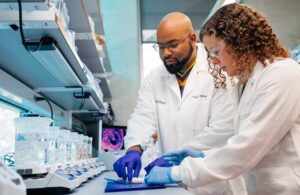
Jervaughn Hunter, the paper’s first author, left, with his Ph.D. adviser, UC San Diego bioengineering professor Karen Christman, in the lab. They took part in the research establishing a hydrogel as a potential mitigation for right ventricle damage. [Image courtesy of UCSD]
Researchers say an injectable hydrogel could mitigate damage to the right ventricle of the heart with chronic pressure overload.
The research came out of the University of California San Diego, Georgia Institute of Technology and Emory University. Investigators published their work in Journals of the American College of Cardiology: Basic to Translational Science.
For this study, they used rodents, but a 2019 FDA-approved Phase 1 trial demonstrated the hydrogel’s safety in humans who suffered a heart attack. As a result of the new preclinical study, the FDA approved an investigational new drug application (NDA). The teams at Emory and Georgia Tech can start a clinical trial with the hydrogel in pediatric patients in the coming months.
In a post on the UCSD website, the researchers say they intended the hydrogel for children born with a condition that leaves them with an underdeveloped, nonfunctional left ventricle. This disorder, called hypoplastic left heart syndrome, comprises less than 4% of congenital heart defects. However, the researchers say it holds responsibility for 40% of deaths associated with heart defects in newborns. They cite a 35% survival rate in patients with this disorder.
Currently, three open-heart surgeries before the patient turns five constitute the treatment options for this disorder. These surgeries reroute oxygenated blood to the right ventricle. Pediatric patients who survive into childhood post-surgery also receive medication and physical therapy while adhering to a special diet.
According to the researchers, eventually, these patients experience right ventricle failure and require a heart transplant.
“To the best of our knowledge, it’s the first time that an injectable biomaterial therapy has been evaluated to mitigate right ventricular heart failure,” said Jervaughn D. Hunter, the paper’s first author, out of UCSD.
In the rodent study, injecting the hydrogel into the right ventricle improved function and allowed the heart to tolerate increased blood pressure and volume. The treatment also slowed down the rate of tissue scarring and maladaptive muscle growth. Researchers hope the hydrogel injection increases the amount of time the patient’s heart functions.
This could lead to dramatically improved quality of life, better cognitive function and enhanced growth. Michael E. Davis, a senior author and professor of biomedical engineering at Georgia Tech and Emory, said this could enable the patients to wait until they can get on an adult heart transplant list.
“This isn’t a cure, but our goal is to prolong a patient’s life,” said Karen Christman, a bioengineering professor at UCSD and the paper’s corresponding author.
The hydrogel is made from cardiac extracellular matrix that is stripped of the cellular content through a cleansing process, dried and milled into powder form, then liquefied into a fluid that can be easily injected into the heart. Once it hits body temperature and pH, the liquid turns into a semi-solid, porous gel. It then encourages the patient’s own cells to repopulate areas of damaged cardiac tissue and to improve heart function.
Researchers say that, in the preclinical trials, they first saw the effects of the treatment two weeks after injection. They also prepared the hydrogel with tissue from both the right and left ventricles of the pig hearts. With this, they found that tissues on each side of the heart differ “vastly.”
Hydrogels from either side of the heart led to improved systolic function and reduced heart muscle growth and scarring while prompting arteriole formation and growth. Overall, though, they found that hydrogel derived from left-ventricle tissue proved more effective. The injected hydrogel also affected gene expression, specifically with pathways related to cardiac repair, including the development of the circulatory system, muscle structure and vasculature, plus the regulation of immune response and cellular response to oxygen-containing compounds.
The team now hopes to begin recruiting for a clinical trial investigating the treatment’s efficacy in newborns with hypoplastic left heart syndrome.